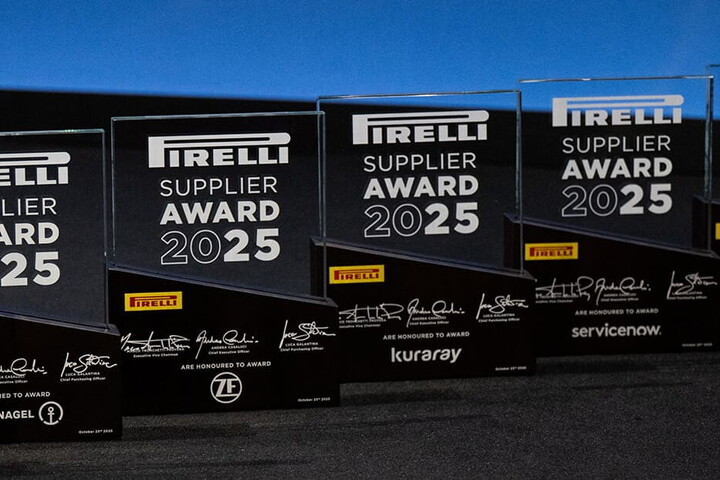Research scientist Riccardo Tebano remembers representing Pirelli in a 2007 project that included the University of California, Berkeley, thinking about how to improve traffic management in the smart cities of the future. Coming from a tyre company, he felt like the odd one out in a room of “smart city” specialists. But in fact he says that worked in his favour.
“We were completely new to the field and so we started thinking from scratch,” says Tebano, a physicist with a PhD in materials science and a recently completed degree in psychology. “And we had some really good ideas.”
On that occasion, Pirelli was the disruptor. Its concept for a system of small underground sensors was the first of its kind that could analyse traffic according to speed and vehicle type. This meant it could detect whether something passing through was a car or a bicycle – crucial if all the cars were stuck in stop-start traffic at the time. The company has a series of patents for the system, although technology has now advanced to use mobile phone data for such analysis. Pirelli has also moved on to concentrate solely on innovation related to the business of tyres.

Disruptive thinking
But the lesson was not lost on Marco Spinetto, Pirelli's head of strategic innovation. Ground-breaking ideas don't come from well-organised systems, he says, but from disruption and entropy. And he's been looking at ways of bringing about disruptive innovation inside Pirelli – in particular with the Sala Futura.
That's the name of a new space set up in two former meeting rooms on the 4th floor of Headquarters 2 in Bicocca. And it's designed as a place where employees from different divisions within Pirelli can come together to generate new thinking on the way things are done. It will mix people from logistics, marketing and customer service, for example, with research scientists and quality-control experts, and make everyone feel like a valued contributor to the process.
“We want to go beyond normal day-to-day activities and rethink what we do,” says Spinetto, who studied nuclear engineering specialising in electronics, and joined Pirelli in 1988. “The structure of the market is very complicated, for example, and could be challenged. There are daily processes around the way we interface with customers for original equipment, or the aftermarket. We are looking to the future for different ideas that can be brought back into the business.”

Creating a space
The Sala Futura has been creating a buzz in a company more used to industrial processes and heavyweight R&D than the fast and furious ideas generation of Silicon Valley stars such as Google and Facebook. A working group of eight people – drawn from departments across the business – was tasked with developing this new space for innovation. And one of them came up with the name “Futura” drawn from a favourite Italian song of 1980 by the late, great thinker and performer Lucio Dalla, in which he shares his hopes and dreams for the future.
The group has also created phrases to give everyone an idea of how the space should be used. These “rules” are posted on the walls. Giuliana Rinaldi from Project Portfolio Management picks one out to illustrate. “This is not a meeting room, you are always welcome,” it says, making the point that people are free to drop by and take part even if they are not officially in the meeting. “Feel free to listen and give your opinion,” says another. “We don't find solutions but we find new questions.”
Inside the Sala is an area for serious brainstorming, with a giant wall of TV screens at one end and a magic whiteboard with a touch screen at the other. The boardroom-size table splits into desks for smaller group work. Then there is a space with bean-bag chairs and flip charts for more free thinking and a breakout area with kitchen facilities, table football and a library. A design agency has advised on the look and feel of the place – from purple and orange floors to the mass of plants.
Through a doorway is the Materioteca® where people will be encouraged to pick up new materials, make things and test them out, as well as use the 3D printers and tools.
Building synergies
The first structured project in the Sala Futura involves 30 people who were set a specific business challenge by Pirelli's top management. Over six months they will develop plans in response to that challenge and create feasibility studies for their ideas. Then they will present them to a steering committee, which will decide which one to adopt and, hopefully, bring to market. The programme took a year to develop, with the help of an external consultancy, and is run by Monica Silvi from the R&D Product Academy along with the human resources department.
But the Sala Futura is also open for other bookings – for a maximum of half a day at a time – and in its first weeks is already booked up. A small-scale model of the space, complete with plants and table football, helped to generate interest when it went on display in the building's reception area. And there are plans to invite visiting speakers from start-up companies in the automotive and other sectors.
“This is a totally new space that hasn't existed before in Pirelli,” says Alberto Bordini from the corporate press office, who was part of the inter-departmental Futura development team. “We have all studied different things and have different backgrounds but we are all colleagues and we can create a sort of synergy together with the same goals in mind.”




